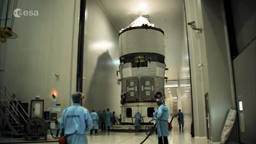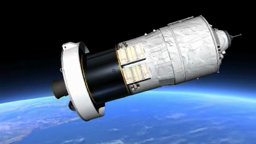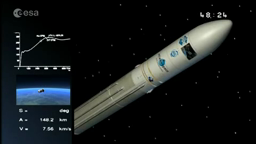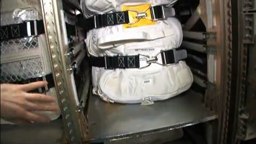 |
13 Feb 2014 |
|
ATV Johannes Kepler (ATV-2) is the first operational ATV, following the highly successful ATV Jules Verne qualification flight in 2008. With a total mass of over 20 tonnes, it is the heaviest payload ever launched by Europe. ATV is a highly sophisticated spacecraft, combining an autonomous free-flying platform, a manoeuvrable space vehicle and %u2013 when docked %u2013 a space station module. To achieve an automated docking under the very tight safety constraints imposed by human spaceflight rules, ATV carries high-precision navigation systems, highly redundant flight software and a fully autonomous collision-avoidance system with its own independent power supplies, control and thrusters. About 10 m high with a diameter of 4.5 m, ATV includes a 45-cubic m pressurised module and a Russian docking system, similar to those used on the Soyuz manned ferries and the Progress resupply ships. With its solar wings deployed, ATV spans 22 m. Almost three times larger than Russia's Progress, it can also deliver about three times the cargo load. ESA's latest Automated Transfer Vehicle is ready for launch to the International Space Station on Tuesday, 15 February at 22:08 GMT from Europe's Spaceport in Kourou, French Guiana. The unmanned spaceship will deliver essential supplies and reboost the Station during its mission lasting three and half months. |

|

|
The making of ATV-2
See how ATV Johannes Kepler (ATV-2) was made. From bits and pieces to a fully built spacecraft squatting atop Ariane 5 ready to go - this video tells " "the story so far" of ATV-2
|

|
ATV-2 mission animation
ATV-2 animation sequence of the full mission.
|

|
ATV-2 launch
ESA's second Automated Transfer Vehicle, Johannes Kepler, has been launched into its targeted low orbit by an Ariane 5. The unmanned supply ship is planned to deliver critical supplies and reboost the International Space Station during its almost four-month mission. The Ariane 5 lifted off from Europe's Spaceport in Kourou, French Guiana, at 21:50 GMT (18:50 local) on Wednesday 16 February. The launcher and its 20.06-tonne payload flew over the Atlantic towards the Azores and Europe. An initial 8-minute burn of the upper stage injected it, with Johannes Kepler, into a low orbit inclined at 51.6 degrees to the equator. After a 42-minute coast, the upper stage reignited for 30 seconds to circularise the orbit at an altitude of 260 km. About 64 minutes into flight, the unmanned supply ship separated safely from the spent upper stage. The Automated Transfer Vehicle (ATV) deployed its four solar wings soon after and will proceed with early orbit operations over the coming hours to begin its climb to the International Space Station (ISS). |

|
ATV-2 launch and docking
ATV Johannes Kepler was launched by an Ariane 5 from Europe's Spaceport in Kourou, French Guiana, on 16 February. It will remain docked to the Station until June, serving as an additional module, providing a shirtsleeve environment for the astronauts and reboosts to move the complex to a higher altitude. Eight days after launch, ESA's latest Automated Transfer Vehicle, Johannes Kepler, completed a flawless rendezvous and docking with the International Space Station at 17:08 CET (16:08 GMT) to deliver essential supplies. The approach and docking were achieved autonomously by its own computers, closely monitored by ESA and French space agency (CNES) teams at the ATV Control Centre in Toulouse, France, as well as the astronauts on the Station. ATV's own second set of sensors and computers provided an independent check. ATV Johannes Kepler closed in on the ISS from behind in order to dock with Russia's Zvezda module. At close range, the 20-tonne unmanned spaceship computed its position through sensors pointed at laser reflectors on the Station to determine its distance and orientation relative to its target. ATV's docking probe was captured by the docking cone inside Zvezda's aft end at 16:59 CET (15:59 GMT). The closure of hooks completed the docking sequence some nine minutes later. |

|
ATV-2 docking and ingress
ATV2 has docked and ingress has been completed. This video is a hihglight of those activites. From now on, ATV is a fully functional albeit temporary extension of the ISS, the vessel can start to fulfil its major mission objective %u2013 to provide services to the ISS.
|



